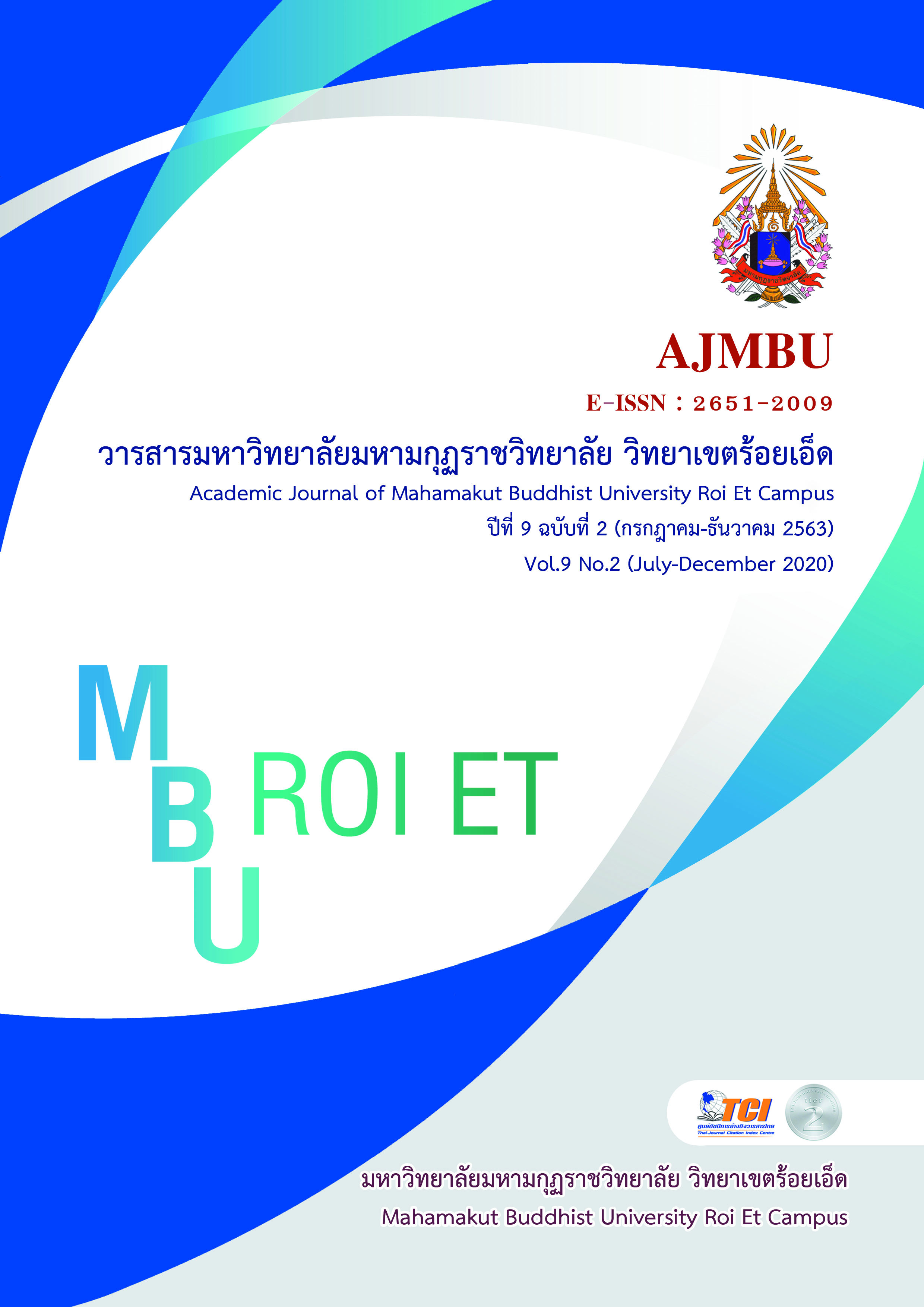Approaches in Developing the Potentiality of Temples to Buddhist Art Tour Destinations and Pilgrimage Route : A Case Study of Temples in the Area of Maha Sarakham Province
Main Article Content
Abstract
The objectives of the research were to 1)search for temples in Maha Sarakham province which had potential to be developed as Buddhist art tour destinations and pilgrimage routes; 2) study guidelines for developing temples in Maha Sarakham province to be Buddhist art tour destinations and pilgrimage routes; and 3) present a map of Buddhist art tour destinations and pilgrimage routes in Maha Sarakham province. The sample consisted of 18 interviewees. The research instruments were two semi-structure interviewing forms.
The results of the study were as follows: 1) The temples in Maha Sarakham province which had the highest potential to be developed as Buddhist art tour destinations could be arranged in descending order as follows: Buddha Wanaram Temple, Buddha Mangala Temple, and Ban Kaen Thao Dhamma Practice Center. The other nine temples with potential to be developed as Buddhist art tour destinations and pilgrimage routes included KLang Kosum Temple, Rerai Forest Temple, Buddha Pradit Temple, DhammaUttayan Forest Temple, Ku Suntraram Temple, Nong Lao Temple, Chai Mangala Temple, Nong Hu Ling Temple, and Klang Kudrang Temple. 2) The guidelines for developing temples in Maha Sarakham province to be Buddhist art tour destinations and pilgrimage routes were as follows: for the Temple area aspect, temples should have a prominent and interesting areas so that they could be symbolic places of Buddhism; for temple personnel aspect, the temple personnel should be educated, self-sacrificing, and responsible; for temple activity management aspect, there should always be new interesting activities; for temple public relation, there should be constant responses to the tourist needs with the least expense, for temple touring management participation aspect, temples should provide opportunities for all people to see activities and services provided by the temples which brought about the transparency, acceptance, and faith. And 3) The map of Buddhist art tour destinations and pilgrimage routes in Maha Sarakham province depicted 12 temples that had the potential to be developed as Buddhist art tour destinations and pilgrimage routes. These temples were Buddha Pradit Temple, KLang Kosum Temple, Klang Kudrang Temple, Dhamma Uttayan Forest Temple, Nong Lao Temple, Chai Mangala Temple, Ban Kaen Thao Dhamma Practice Center, Buddha Wanaram Temple, Buddha Mangala Temple, Ku Suntraram Temple, Rerai Forest Temple, and Nong Hu Ling Temple.
Article Details
References
กระทรวงการท่องเที่ยวและกีฬา. (2560). แถลงข่าวสถานการณ์ท่องเที่ยว พฤษภาคม 2560. สืบค้นเมื่อ 23 เมษายน 2561. จาก https://www.mots.go.th/more_news.php?cid=421&filename=index
จุฑาภรณ์ หินซุย, สถาพร มงคลศรีสวัสดิ์. (2557). แนวทางส่งเสริมการท่องเที่ยวเชิงพุทธ : กรณีศึกษาวัดประชาคมวนาราม อำเภอศรีสมเด็จ จังหวัดร้อยเอ็ด. วารสารวิชาการการท่องเที่ยวไทยนานาชาติ. 10(1). 50-58.
ชัยธวัช ศิริบวรพิทักษ์. (2560). การวางแผนพัฒนาศักยภาพการท่องเที่ยวของจังหวัดมหาสารคาม.วารสารมนุษยศาสตรและสังคมศาสตร์. 8(2). 73-78.
มาโนช พรหมปัญโญ. (2556). แนวทางการเตรียมความพร้อมการท่องเที่ยวเชิงพุทธของจังหวัดอุบลราชธานี เพื่อรองรับการเข้าสู่ประชาคมอาเซียน.วารสารการบริการและการท่องเที่ยวไทย. 8(2). 36-47.
ภัทรา แจ้งใจเจริญ. (2559). การจัดการการท่องเที่ยวเชิงวัฒนธรรม กรณีศึกษา ชุมชนโอหงิมาจิหมู่บ้านชิราคาว่าโก จังหวัด กิฝุ ประเทศญี่ปุ่น. วารสารญี่ปุ่นศึกษา. 33(2). 79-97.
ลินจง โพชารี. (2560). แนวทางการพัฒนาการท่องเที่ยวของจังหวัดมหาสารคาม. การประชุมวิชาการ มหาวิทยาลัยมหาสารคามวิจัย ครั้งที่ 13. สืบค้นเมื่อ 19 เมษายน 2561. จากhttp://research.msu.ac.th/msu_journal/upload/articles/article1931_78104.pdf
สำนักงานจังหวัดมหาสารคาม. (2555). ข้อมูลทั่วไปจังหวัดมหาสารคาม. สืบค้นเมื่อ 20 เมษายน
2561. จาก http://www.mahasarakham.go.th/mkweb/index.php/new-data/238
อารีย์ นัยพินิจ และคณะ. (2556). การศึกษาศักยภาพการท่องเที่ยวเชิงศาสนาของวัดในกลุ่มจังหวัดร้อยแก่นสารสินธุ์. วารสารปัญญาภิวัฒน์. 5(1). 31-40.


